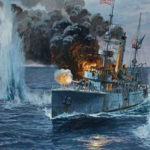
Even, perhaps especially, in defeat there is often extraordinary sacrifice and courage that deserves to be remembered.
USS Asheville (PG-21) under the command of Lieutenant Commander Jacob W. Britt was one of the last ships to evacuate Java, left behind due to an engine casualty, reducing speed to 10kts. Unbeknownst to Britt, between Asheville and the relative safety of Australia are four Japanese Pearl Harbor-veteran carriers, four battleships, numerous cruisers, destroyers, submarines and hundreds of land-based bombers; and the Japanese know the compromised allied rendezvous point (COMSEC violation). Sighting the Asheville alone at dawn on 3 Mar 1942, the Japanese destroyers Arashi and Nowaki, backed up by a heavy cruiser, close for the kill with a 20kt speed advantage armed with twelve 5″ guns and sixteen 24″ torpedoes against Asheville’s three 4″ guns. Asheville does not strike her colors, raise a white flag, jump into the lifeboats or scuttle the ship. Instead, Asheville opens fire, and she keeps firing as long as she is able. It takes the two top-of-the-line Japanese destroyers over 30 minutes and 300 rounds to put the archaic China gunboat under; an action viewed by the Japanese as a total fiasco but typical of the prodigious expenditure of surface ammunition to little effect, by both sides, during the course of the campaign. The Japanese rescued one Sailor and left the rest to perish as they hurried to massacre an Allied convoy just over the horizon. Engineman Fred L. Brown died in Japanese captivity in March 1945 from the combined untreated effects of disease and beatings, and the story of the Asheville is known only via another POW from the sunken USS Pope (DD-225) and fragmentary Japanese reports. Because no witnesses survived the war, there are no Medals of Honor, no Navy Crosses, no unit citations, just the dim memory of a brave crew of 166 men who fought valiantly without hope, lost somewhere about 160 NM SW of Bali.
Source: Naval History and Heritage Command
